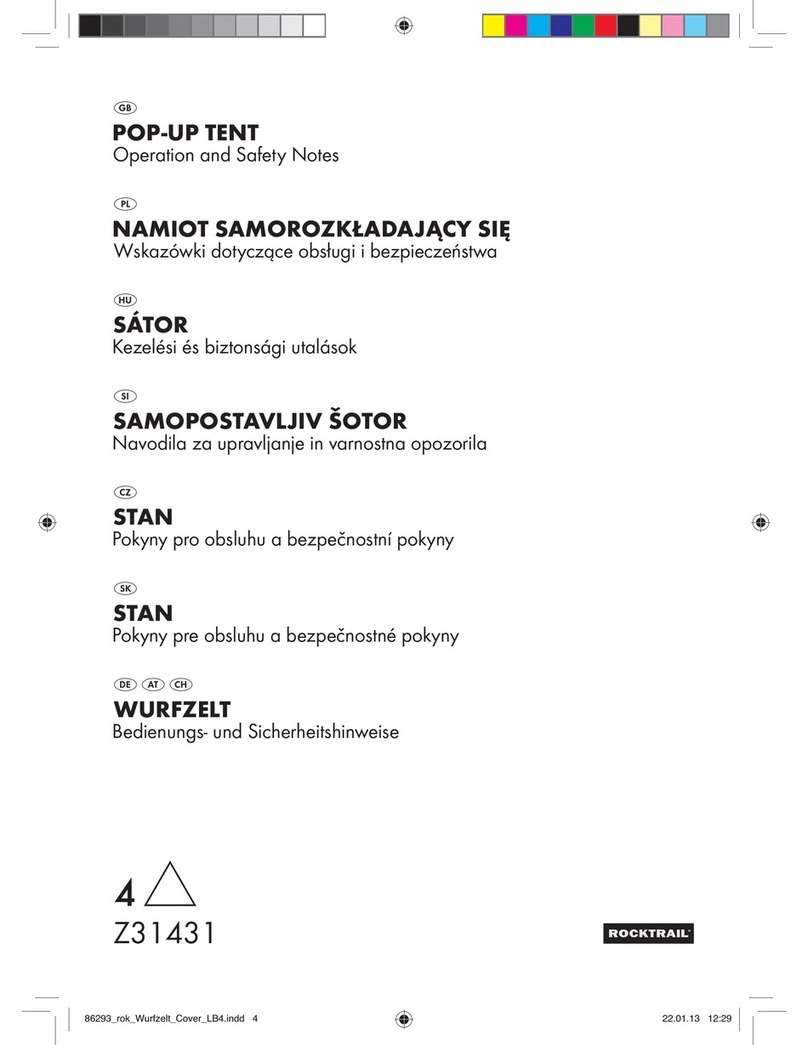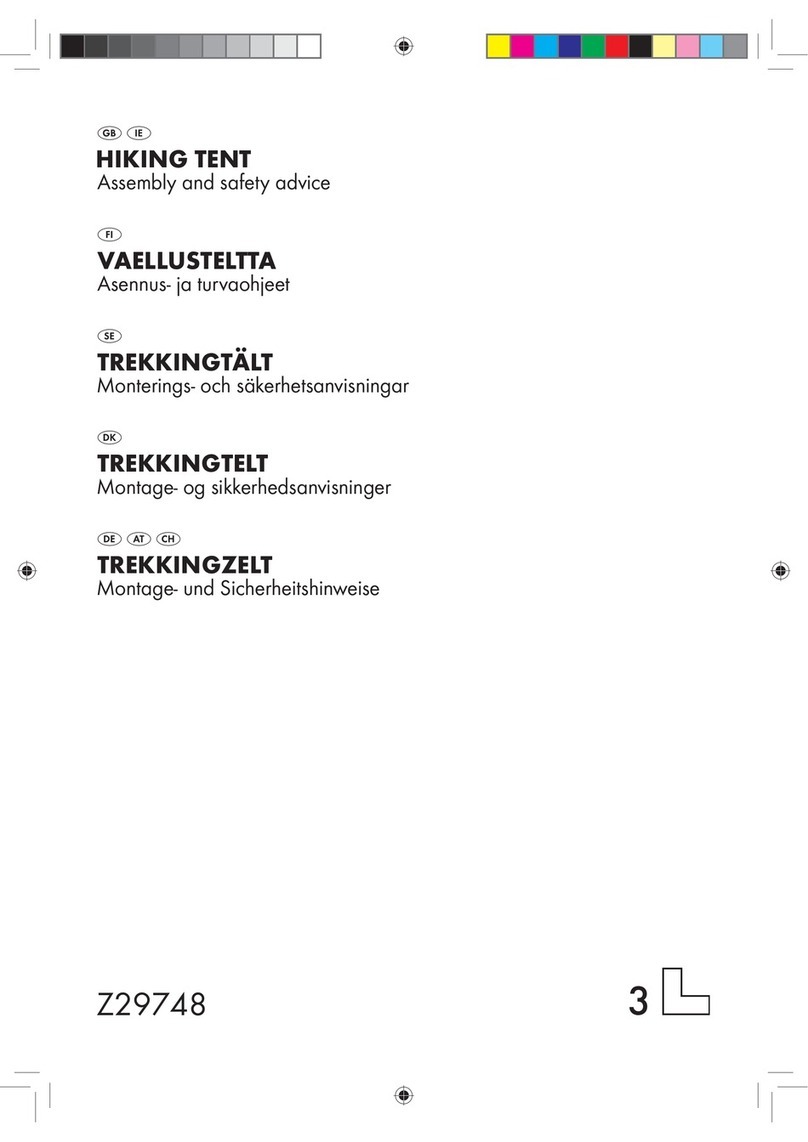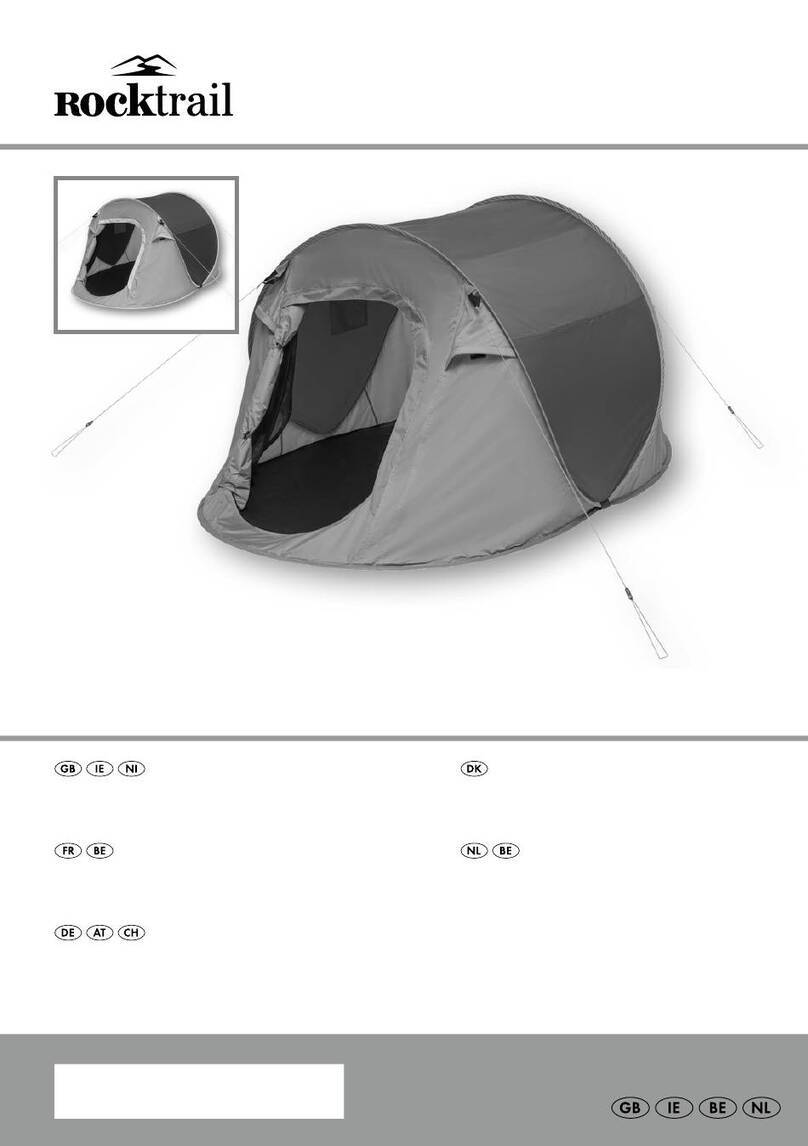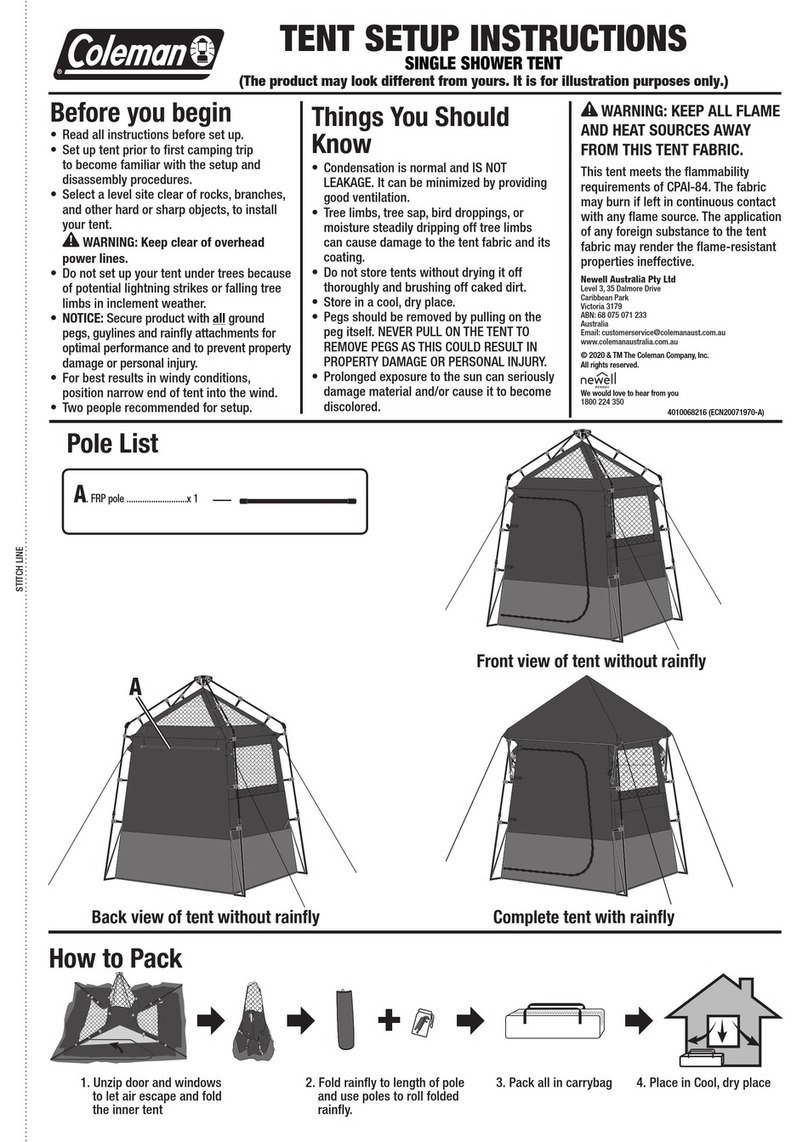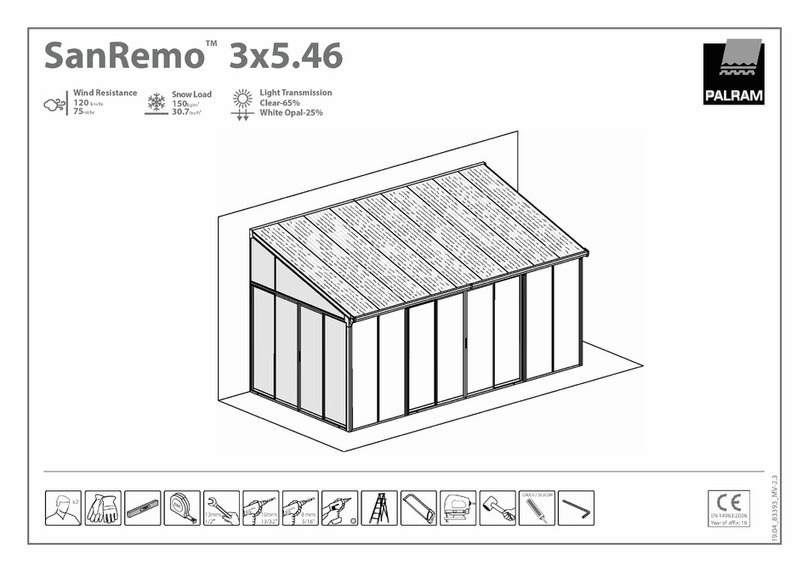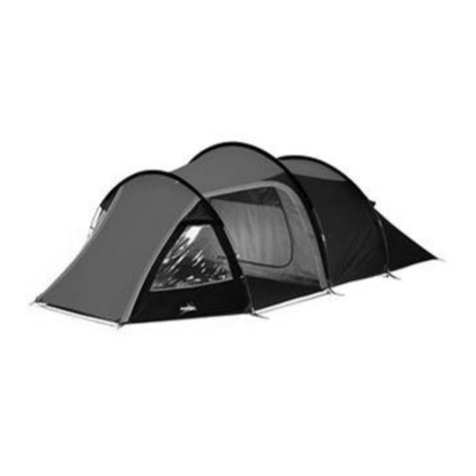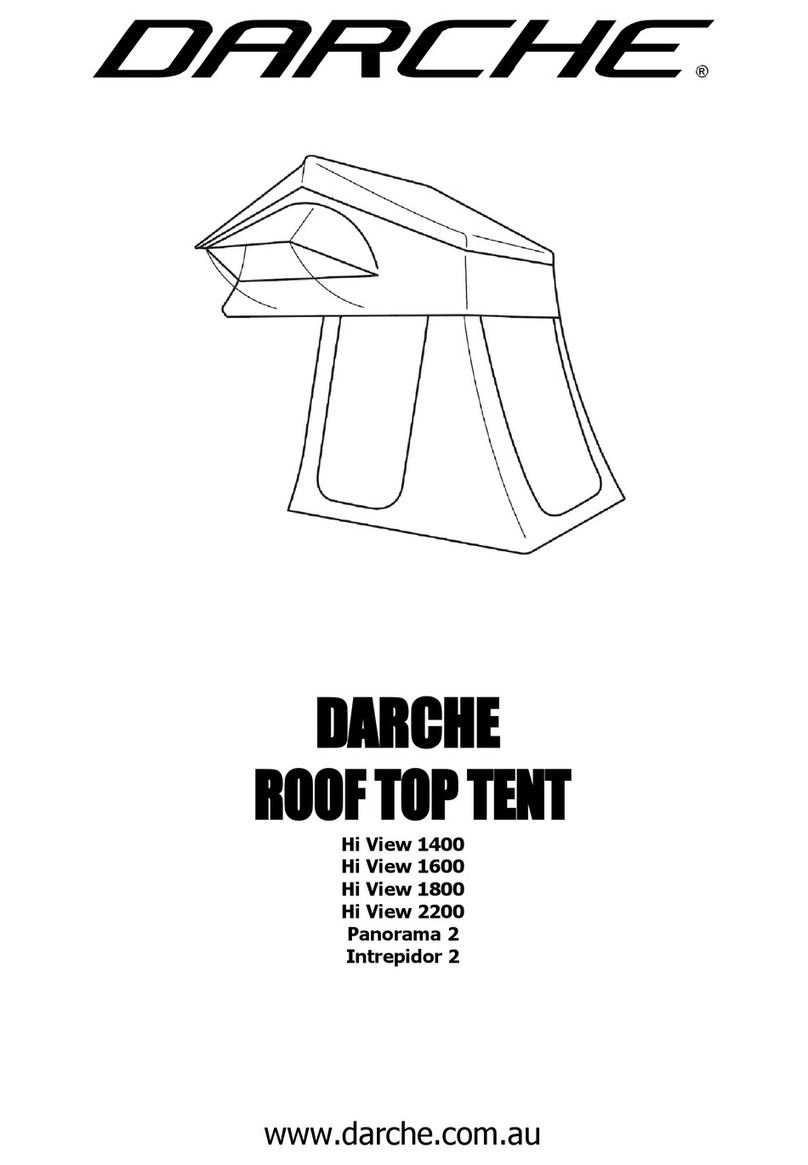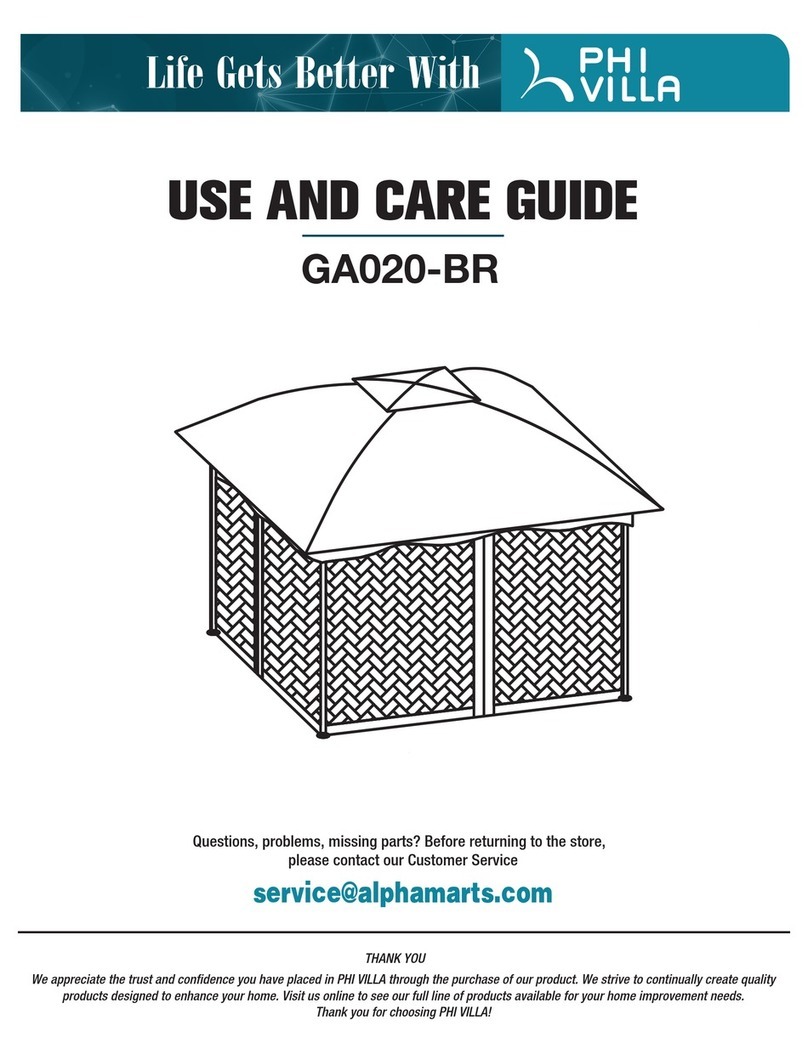Rocktrail Z29748 Installation and operating instructions

TREKKINGZELT
Montage- und Sicherheitshinweise
TIENDA DE TREKKING
Instrucciones de montaje y de advertencias de seguridad
TENDA DA TREKKING
Istruzioni di sicurezza e montaggio
HIKING TENT
Assembly and safety advice
TENDA DE CAMPISMO
Indicações de montagem e segurança
5Z29748

ES Instrucciones de montaje y de advertencias de seguridad Página 3
IT/MT Istruzioni di sicurezza e montaggio Pagina 5
PT Indicações de montagem e segurança Página 7
GB/MT Assembly and safety advice Page 9
DE/AT/CH Montage- und Sicherheitshinweise Seite 11

3ES
Tienda de trekking
Uso adecuado
Este producto es apto como alojamiento en viajes
y para acampar. El producto no ha sido concebido
para uso comercial.
Descripción de piezas
1Tienda
2Barra (4 elementos) con pieza articulada
3Barra (4 elementos)
4Barra (10 elementos)
5Cuerda tensora
6Piquete
7Dispositivo para fijar la cuerda tensora
8Guía de barra
9Collar
10 Bolsa
Indicaciones de seguridad
¡LEA LAS INSTRUCCIONES DE MONTAJE ANTES
DE UTILIZAR EL PRODUCTO! ¡CONSÉRVELAS EN
UN LUGAR SEGURO!
¡PRECAUCIÓN! ¡PELIGRO DE LESIONES!
Asegúrese de que todas las piezas hayan sido
montadas correctamente y en perfecto estado.
Existe peligro de lesiones en caso de montaje
inadecuado. Las piezas defectuosas pueden
afectar a la seguridad y la función.
¡PRECAUCIÓN! No deje a los niños sin vigi-
lancia. ¡El producto no es un juguete! Asegúrese
de que nadie se suba ni apoye en el producto,
especialmente los niños. El producto podría
desequilibrarse y volcar. Esto podría ocasionar
lesiones y/o daños materiales.
¡PRECAUCIÓN! ¡PELIGRO DE LESIONES!
No monte o desmonte nunca el producto
cuando haya viento intenso.
Elija, en la medida de lo posible, una base
firme y llana para montar la tienda.
Las superficies arenosas reducen la estabilidad.
Busque una base firme que ofrezca sujeción
para los piquetes.
¡No clave los piquetes en el suelo con violencia!
Prolongue eventualmente el atirantado con un
lazo y colocar el piquete en otro lugar.
Compruebe regularmente el estado de todos
los puntos de unión y el atirantado, así como
el firme asiento de los piquetes.
Una secuencia de montaje incorrecta puede
dañar la tienda. Se excluye toda responsabilidad.
¡PRECAUCIÓN! ¡PELIGRO DE INTOXI-
CACIÓN Y DAÑOS MATERIALES! No
encienda ningún fuego dentro del producto y
manténgalo alejado de cualquier fuente de calor.
Las medidas para la prevención de incendios
se encuentran en una etiqueta cosida en el
interior de la tienda. Recomendamos no retirar
dicha etiqueta.
Familiarícese con la normativa local contra
incendios (p.ej. camping).
¡Mantenga la salida libre de obstáculos! No
obstaculice la salida con objetos.
Tenga en cuenta las influencias
climatológicas
A la hora de elegir el lugar de montaje tenga
siempre en cuenta las características del lugar
y eventuales cambios que puedan producirse.
¿Podría inundarse el emplazamiento en caso
de lluvia? Tenga en cuenta el eventual incre-
mento del nivel de agua de ríos o mareas.
Proteja el producto contra vientos fuertes y
tormentas. Monte el producto, dentro de lo
posible, en un lugar protegido del viento.
En caso de viento intenso, sustituya previa-
mente los piquetes normales por piquetes
especiales para vientos fuertes. Consulte a su
distribuidor habitual la eventual utilización de
accesorios útiles.
Desmonte la tienda antes de fuertes nevadas o
temporales.
Retire la nieve que se encuentre sobre el pro-
ducto. De lo contrario, el producto podría
hundirse bajo el peso.
No tense la tienda en exceso, ya que si no,
ésta no podrá adaptarse a las condiciones

4 ES
climatológicas cambiantes, pudiendo resultar
dañada.
Las cremalleras son piezas de desgaste y no
están cubiertas por la garantía.
El tejido de poliéster de la tienda es hidrófugo.
Podría ocurrir que la tienda no sea completa-
mente estanca con la primera lluvia. No obs-
tante, la lluvia contrae las fibras de la tienda,
quedando ésta estanca en breve.
El tejido de la tienda se expande de diferente
manera con la lluvia y la humedad, por lo que
se debe ajustar el atirantado de la misma. Cuando
el material vuelve a tensarse al secarse, se
deben aflojar de nuevo los tirantes a tiempo.
No utilice sprays insecticidas en o sobre la
tienda.
Las fugas de pequeño tamaño se pueden sellar
con un spray para costuras y para la superficie
de la tienda se puede emplear un spray para
impregnar.
Montaje
Selección del emplazamiento
El suelo debe ser llano, estar limpio y no debe pre-
sentar irregularidades. Retire previamente objetos
punzantes y cortantes (p.ej. piedras, ramas, etc.).
Asegúrese de colocar la tienda 1de forma que
la entrada se encuentre al resguardo del viento.
A la hora de elegir el emplazamiento asegú-
rese de que exista espacio suficiente alrededor
de la tienda 1para poder moverse y para fijar
las cuerdas tensoras. Tenga también en cuenta
que debe existir espacio suficiente alrededor
de la tienda 1para caminar sin tropezarse.
Montaje de la tienda
Monte el producto tal y como se muestra en
las ilustraciones A a C.
Guardar la tienda
Asegúrese de que la tienda 1esté completa-
mente seca antes de guardarla. De lo contrario,
podrían aparecer manchas en el tejido.
Pliegue siempre la tienda 1de tal forma, que
el suelo de la misma quede mirando hacia
fuera.
Los piquetes
6y otras piezas individuales deben
guardarse por separado en las bolsas corres-
pondientes. De lo contrario, los piquetes 6
podrían dañar la tienda 1.
Limpieza
Utilice para la limpieza y las manchas exclusi-
vamente un limpiador especial para tiendas de
campaña de poliéster.
Limpie la suciedad de la tienda 1con una
esponja suave y agua limpia.
Deje secar todas las piezas completamente
antes de guardar la tienda 1. Ello evita la
aparición de moho, formación de malos olores
y coloraciones.
Eliminación
El embalaje se compone de materiales
reciclables que puede desechar en los
puntos locales de recogida selectiva.
Para deshacerse del producto una vez terminada
su vida útil pregunte a las autoridades locales o
municipales.

5IT/MT
Tenda da trekking
Utilizzo determinato
Questo prodotto è adatto a essere utilizzato quale
ricovero durante un viaggio o per il campeggio. Il
prodotto non è determinato per l‘uso professionale.
Descrizione dei componenti
1Tenda
2Asta (in 4 parti) con elemento snodabile
3Asta (in 4 parti)
4Asta (in 10 parti)
5Tirante
6Picchetto
7Dispositivo di serraggio per tirante
8Guida per aste
9Supporto di ancoraggio
10 Borsa
Avvertenze di sicurezza
PRIMA DELL’USO LA PREGHIAMO DI LEGGERE LE
ISTRUZIONI DI MONTAGGIO! LA PREGHIAMO
DI CONSERVARE PER BENE LE ISTRUZIONI DI
MONTAGGIO!
ATTENZIONE! PERICOLO DI LESIONE!
Assicuratevi che tutti i pezzi siano indenni e
montati giustamente. Un montaggio bistratto può
causare pericoli di lesione. I pezzi danneggiati
possono influenzare la sicurezza e la funzione.
ATTENZIONE! Non lasciate i bambini inos-
servati! La serra da giardino non è un attrezzo
per giocare o arrampicarsi! Assicuratevi che
nessuno vi si appoggi, e soprattutto che nessun
bambino si arrampichi sulla serra. La serra po-
trebbe sbilanciarsi e ribaltare. Un‘inosservanza
può causare pericolo di lesioni e/ o danni.
ATTENZIONE! PERICOLO DI LESIONE!
Non montare e smontare mai questo prodotto
con vento forte.
Scegliere come punto di montaggio un
sottofondo possibilmente compatto e piano.
Le superfici in sabbia riducono la stabilità della
tenda. Fare attenzione a che venga scelto un
sottofondo che offra stabilità ai picchetti.
Non piantare mai i picchetti nel terreno con
violenza! Prolungare eventuali ancoraggi
per mezzo di un occhiello e porre il tirante in
un’altra posizione.
Controllare con regolarità l’integrità di tutti i
punti di raccordo, verificare gli ancoraggi e
controllare che i picchetti siano ben fissi nella
loro sede.
Un’errata sequenza di montaggio potrebbe
danneggiare la tenda. Viene escluso l’utilizzo
di adesivi di qualsiasi tipo.
ATTENZIONE! PERICOLO DI INTOSSI-
CAZIONE E PERICOLO DI DANNI
MATERIALI! Non fate un falò all´interno del
prodotto e tenetelo lontano da fonti di calore.
Su un’etichetta cucita nell’interno della tenda
sono riportate misure preventive che si devono
attuare per impedire che scoppino incendi. Si
suggerisce di non rimuovere questa etichetta.
Per prima cosa familiarizzarsi con le disposizioni
antincendio in vigore nel luogo di montaggio
della tenda (ad esempio in un campeggio).
Mantenere libera l’uscita! Non bloccare l’uscita
ponendo oggetti davanti a essa.
Fare attenzione alle condizioni di tempo
atmosferico e alle loro conseguenze
Nella scelta dell’area di montaggio tenere
sempre conto delle caratteristiche del luogo e
sulle sue eventuali possibilità di mutamento delle
caratteristiche medesime. Ad esempio, l’area
di montaggio ha caratteristiche tali che in caso
di pioggia essa si allaga? Tenere conto dell’e-
ventuale presenza di fiumi o di maree in crescita.
Proteggere l’articolo da forte vento e da
tempesta. Porre l’articolo, se possibile, in un
luogo protetto dal vento.
Prima dell’insorgere di forte vento sostituire i
picchetti normali con picchetti speciali resistenti
alla tempesta. Informarsi in un negozio specializ-
zato dell’eventuale disponibilità di accessori utili.

6 IT/MT
Smontare la tenda prima di una forte nevicata
o di tempesta.
Rimuovere subito la neve dal prodotto. In caso
contrario il prodotto potrebbe crollare sotto il
peso della neve.
Non installare la tenda in modo troppo teso, in
caso contrario essa non si potrá adattare alle
mutevoli condizioni di tempo e subirà dei danni.
Le cerniere sono parti soggette ad usura e non
rientrano nell’applicazione della garanzia.
Il poliestere della tenda è realizzato da materiale
idrorepellente.
E’ possibile che la tenda all’inizio della precipi-
tazione piovosa non sia completamente imper-
meabile. L’umido fa tuttavia in modo che i fili
della tenda si contraggano e in questo modo la
tenda in breve tempo diventerà impermeabile.
In caso di umidità e di pioggia i tessuti della
tenda si dilatano in modo diverso e rendono
necessario un nuovo tensionamento dei tiranti.
Quando il materiale, durante l’asciugamento,
diventa nuovamente teso, i tiranti devono essere
di nuovo allentati per tempo.
Non utilizzare alcun spray anti-insetti nella
tenda o su di essa.
Eventuali piccoli punti non a tenuta alle cuciture
possono esser riparati con uno spray per
cuciture e per il telo della tenda può essere
utilizzato uno spray impregnante.
Montaggio
Scelta del punto di montaggio
Lo stato del terreno deve essere piano, pulito e libero
da dislivelli. In primo luogo rimuovere oggetti appun-
titi o con spigoli vivi (ad esempio pietre, rami ecc.).
Assicurarsi che la tenda 1sia posizionata in
modo tale che l’ingresso si trovi sottovento.
Fare attenzione a che nella scelta del luogo di
montaggio accanto alla superficie occupata
dalla tenda 1vi sia ancora posto per gli
ancoraggi. Assicurarsi inoltre che attorno alla
tenda 1vi sia sufficiente spazio per camminare
e non vi sia il rischio di inciampo.
Montaggio della tenda
Montare il prodotto in base alle immagini A-C.
Imballaggio della tenda
Prima di imballarla, assicurarsi che la tenda 1
sia completamente asciutta. In caso contrario
possono svilupparsi macchie e danni al tessuto.
Raccogliere la tenda 1sempre in modo tale
che la base della tenda medesima mostri verso
l’esterno.
I picchetti 6e gli altri singoli pezzi devono
essere imballati separatamente nelle tasche
previste a tale scopo. In caso contrario i
picchetti 6danneggiano la tenda 1.
Pulizia
Per la pulizia e in caso di presenza di macchie
utilizzare solamente un detergente speciale per
tende in poliestere.
Rimuovere lo sporco dalla tenda 1con uno
straccio soffice e acqua corrente.
Lasciare asciugare completamente tutti i
componenti prima di imballare nuovamente
la tenda 1. Ciò impedisce lo sviluppo di
muffa, cattivo odore e scolorimenti.
Smaltimento
La confezione è prodotta in materiale
riciclabile e biodegradabile, smaltibile
nei luoghi di raccolta differenziati.
Informazioni sulle possibilità di smaltimento del
prodotto consumato sono reperibili dall‘amministra-
zione comunale o cittadina.

7PT
Tenda de campismo
Utilização correcta
Este produto destina-se ao abrigo de pessoas em
viagem e campismo. Este artigo não é indicado
para uma utilização comercial.
Descrição das peças
1Tenda
2Barra (4 partes) com parte superior de
articulação
3Barra (4 partes)
4Barra (10 partes)
5Corda de firmar
6Estaca
7Dispositivo de fixação para a corda de firmar
8Guia das barras
9Base para fixação no solo
10 Saco de transporte
Indicações de segurança
ANTES DE UTILIZAR, LEIA O MANUAL
DE MONTAGEM! GUARDE O MANUAL
DE MONTAGEM CUIDADOSAMENTE!
CUIDADO! PERIGO DE FERIMENTOS!
Certifique-se de que todas as peças estão em
bom estado e correctamente montadas. Se a
montagem não for efectuada de uma forma
adequada existe perigo de ferimentos. As pe-
ças danificadas podem afectar a segurança e
o funcionamento do produto.
CUIDADO! Não deixe as crianças sem vigi-
lância! O produto não é um brinquedo, nem é
adequado para trepar! Certifique-se de que
ninguém, especialmente crianças, trepa para
cima do produto ou se encosta a ele. O pro-
duto pode perder o equilíbrio e virar-se. Isto
pode provocar ferimentos e/ou danos.
CUIDADO! PERIGO DE FERIMENTOS!
Nunca monte e desmonte o produto em caso
de vento forte.
Escolha como local uma superfície o mais
firme e plana possível.
Superfícies arenosas reduzem a estabilidade.
Certifique-se de que a superfície fornece uma
fixação firme para as estacas.
Nunca crave as estacas com violência no
chão! Se for necessário prolongue as cordas
com a ajuda de um laço e coloque a estaca
num outro local.
Monitorize regularmente a integridade de todas
as junções e verifique as cordas e a fixação das
estacas.
Uma sequência incorrecta de montagem
poderá causar danos na tenda. Está excluído
qualquer tipo de responsabilidade.
CUIDADO! PERIGO DE INTOXICAÇÃO
E DE DANOS MATERIAIS! Não acenda
fogo dentro do produto e mantenha-o afas-
tado de fontes de calor.
Medidas de precaução contra fogos encon-
tram-se indicadas numa etiqueta cosida no
interior da tenda. Recomenda-se que esta eti-
queta não seja removida.
Para além disto, no local (p. ex. parque de
campismo, local de acampamento), familia-
rize-se com as regras de protecção contra
incêndios.
Mantenha a saída desimpedida! Não obstrua
a saída com objectos.
Tenha em atenção os impactos do tempo
e das condições atmosféricas
Na escolha do local, tenha sempre em aten-
ção as circunstâncias locais e de como estas
se poderão eventualmente alterar. O local po-
derá ficar alagado no caso de chuva? Tenha
em consideração eventuais subidas dos níveis
de rios e marés.
Proteja o produto de ventos fortes e tempesta-
des. Coloque o produto num local o mais pro-
tegido do vento possível.
Antes da ocorrência de ventos fortes substitua
as estacas normais da tenda por estacas apro-
priadas para tempestade. Informe-se acerca

8 PT
de produtos complementares adequados em
lojas especializadas.
Desmonte a tenda antes da ocorrência de
nevões fortes ou tempestades.
Remova imediatamente a neve do produto. Caso
contrário, o produto pode romper-se com o peso.
Não monte a tenda demasiado esticada, para
que esta se possa adaptar às alterações das con-
dições meteorológicas e não seja danificada.
Os fechos de correr são peças sujeitas a des-
gaste e não estão abrangidos pelas condições
de garantia.
O material em poliéster da tenda é hidrófugo.
É possível que a tenda não se apresente comple-
tamente impermeável na primeira vez que for
exposta à chuva. No entanto, os fios da tenda
contraem-se com a humidade e num curto es-
paço de tempo a tenda torna-se impermeável.
No caso de humidade e chuva, os materiais da
tenda esticam a diferentes níveis e isso torna
necessário o retesar das cordas de firmar.
Quando o material, ao secar, volta a encolher,
as cordas de firmar devem atempadamente ser
alargadas novamente.
Não utilize repelentes de insectos nem na tenda
nem sobre esta.
Os pequenos pontos de fuga nas costuras
podem ser reparados com um spray de veda-
ção de costuras e, para o material exterior da
tenda, pode ser utilizado um spray impermea-
bilizante.
Montagem
Escolher o local
O solo deve ser plano, limpo e sem irregularidades.
Em primeiro lugar deve remover todos os objectos
pontiagudos e com extremidades afiadas (por ex.
pedras, ramos, etc.).
Certifique-se de que a tenda 1é colocada de forma
a que sua entrada se encontre abrigada do vento.
Na escolha do local, tenha em consideração
de que, para além da base da tenda 1,
necessita ainda de espaço para as cordas.
Certifique-se também de que em torno da
tenda 1existe espaço suficiente para se cir-
cular e de que não há perigo de tropeços.
Montar a tenda
Monte o produto de acordo com as figuras de
A a C.
Arrumar a tenda
Certifique-se de que a tenda 1se encontra
completamente seca antes de a arrumar. Caso
contrário, podem ocorrer nódoas e danos no
tecido.
Dobre sempre a tenda 1de modo a que o
chão da tenda fique virado para fora.
As estacas
6e as outras peças soltas devem ser
arrumadas separadamente em sacos destina-
dos a esse fim. Caso contrário, as estacas 6
podem danificar a tenda 1.
Limpeza
Para a limpeza e para as nódoas, utilize unica-
mente um agente de limpeza adequado espe-
cialmente para a tenda de poliéster.
Retire a sujidade da tenda 1com uma esponja
macia e água limpa.
Deixe secar bem todas as peças antes de
embalar novamente a tenda 1. Isto previne
bolor, odores e descolorações.
Eliminação
A embalagem é composta por materiais
recicláveis, que pode eliminar através
dos pontos de reciclagem locais.
Pode obter informações acerca da eliminação do
produto usado junto das autoridades locais respon-
sáveis pela reciclagem.

9GB/MT
Hiking tent
Proper use
This product is suitable for use as accommodation
when travelling and camping. The product is not
intended for commercial use.
Description of parts
1tent
2pole (4-part) with attachment
3pole (4-part)
4pole (10-part)
5guy rope
6tent peg
7tensioner for guy rope
8pole guide
9ground sleeve
10 carrying bag
Safety advice
PLEASE READ THE ASSEMBLY INSTRUCTIONS
BEFORE USING THE PRODUCT! PLEASE KEEP
THE ASSEMBLY INSTRUCTIONS IN A SAFE PLACE!
CAUTION! RISK OF INJURY! Ensure
that all parts are undamaged and have been
assembled appropriately. Risk of injury exists
if assembled incorrectly. Damaged parts can
affect safety and function.
CAUTION! Do not leave children unattended.
The product is not a climbing frame or toy. Make
sure that nobody climbs or leans on the product,
particularly children. The product could become
imbalanced and tip up. This may result in injury
and/or damage.
CAUTION! RISK OF INJURY! Never under
any circumstances assemble the product in a
strong wind.
Select a piece of land that is as flat and firm as
possible to erect your tent.
Sandy surfaces reduce the stability of the tent.
Please ensure that the surface provides a firm
hold for the tent pegs.
Never knock the tent pegs into the ground with
force! If necessary, the guy lines should only
be extended with the help of a loop and the
tent peg positioned in a different location.
The intactness of all connection points and the
guy lines should be checked regularly, as should
the firmness of the tent pegs in the ground.
If the tent is erected in the wrong order, this
may cause damage to the tent. All liability is
excluded in such cases.
CAUTION! DANGER OF POISONING
AND DAMAGE TO PROPERTY! Do not
light any fires within the product and keep it
away from sources of heat.
Precautionary measures with respect to fires are
stated on a label sewn into the inside of the
tent. You are advised not to remove this label.
You should also familiarise yourself with the
local fire protection regulations (e.g. camping
site, tent pitch).
Keep the exit free! Do not block the exit with
objects.
Take note of the effects of the weather
and climate
When selecting the location to put up your tent,
you should always consider the local situation
and how this might change. Will the terrain turn
into a lake if it rains? Please take into account
any rising rivers and incoming tides.
Protect the product against strong wind and
storms. Place the product in a location that is
protected from the wind if possible.
If a strong wind is forecast, replace the normal
tent pegs with special storm pegs. You can find
information about meaningful supplementary
products at specialist shops.
The tent should be taken down before heavy
snowfall or stormy weather.
Remove any snow directly from the product.
Otherwise the product may collapse under the
weight.

10 GB/MT
Ensure that the tent is not too taut when it is
erected, otherwise it may not be able to adapt
to changing weather conditions and might be
damaged.
Zips are wearing parts and do not fall under
the guarantee conditions.
The polyester material of the tent consists of
water-repellent material.
It is possible that during the first rainfall the tent
will not be completely watertight. However, the
threads of the tent will contract when exposed
to water so that after a short time the tent will
become watertight.
When exposed to moisture and rain, tent
fabrics expand to varying degrees and make it
necessary to adapt the length of the guy lines.
If the material becomes taut again while drying,
the guy lines have to be loosened again in
good time.
Do not use any insect spray in or on the tent.
Small leaks on the seams can be repaired with
a seam spray and impregnation spray can be
used for the tent skin.
Assembly
Selecting a pitch
The ground should be flat, clean and as smooth as
possible. Before you erect your tent, remove any
pointed and sharp objects (e.g. stones, branches etc.).
Please ensure that the tent 1is positioned in such a
way that its entrance is protected against the wind.
When selecting a pitch for your tent 1,
remember that you need not only an area for
the floor of the tent, but also room for the guy
lines. You should also ensure that there is
enough space to walk around the tent 1and
that there are no tripping hazards.
Erecting the tent
Erect the product in accordance with illustrations
A to C.
Packing the tent together
Please ensure that the tent 1is completely
dry before you pack it together. Otherwise this
may result in stains and damage to the fabric.
Always fold up the tent 1so that its ground
sheet is facing outwards.
The tent pegs 6and other individual parts must
be packed separately in the bags provided.
Otherwise the tent pegs 6might damage the
tent 1.
Cleaning
For cleaning the tent and removing any stains
you should only use a cleaning agent that is
specifically intended for cleaning polyester tents.
Remove any dirt from the tent 1with a soft
sponge and clean water.
Please allow all parts to dry thoroughly before
you repack the tent 1. This will prevent the for-
mation of mould, bad odours and discolouration.
Disposal
The packaging is made entirely of
recyclable materials, which you may
dispose at local recycling facilities.
Contact your local refuse disposal authority for more
details of how to dispose of your worn-out product.

11DE/AT/CH
Trekkingzelt
Bestimmungsgemäße
Verwendung
Dieses Produkt ist als Unterkunft auf Reisen und
zum Campen geeignet. Das Produkt ist nicht für
den gewerblichen Einsatz bestimmt.
Teilebeschreibung
1Zelt
2Stange (4-teilig) mit Gelenkaufsatz
3Stange (4-teilig)
4Stange (10-teilig)
5Abspannleine
6Hering
7Spannvorrichtung für Abspannleine
8Stangenführung
9Bodenhülse
10 Tragetasche
Sicherheitshinweise
VOR GEBRAUCH BITTE DIE MONTAGE-
ANLEITUNG LESEN! MONTAGEANLEITUNG
BITTE SORGFÄLTIG AUFBEWAHREN!
VORSICHT! VERLETZUNGSGEFAHR!
Stellen Sie sicher, dass alle Teile unbeschädigt
und sachgerecht montiert sind. Bei unsachge-
mäßer Montage besteht Verletzungsgefahr.
Beschädigte Teile können die Sicherheit und
Funktion beeinflussen.
VORSICHT! Lassen Sie Kinder nicht unbeauf-
sichtigt! Das Produkt ist kein Kletter- oder Spiel-
gerät! Stellen Sie sicher, dass Personen,
insbesondere Kinder nicht auf das Produkt klet-
tern bzw. sich nicht am Produkt anlehnen. Das
Produkt könnte aus dem Gleichgewicht kom-
men und umkippen. Verletzungen und/ oder
Beschädigungen können die Folgen sein.
VORSICHT! VERLETZUNGSGEFAHR!
Montieren und demontieren Sie das Produkt
keinesfalls bei starkem Wind.
Wählen Sie einen möglichst festen, ebenerdigen
Untergrund als Standplatz.
Sandige Oberflächen reduzieren die Stabilität.
Achten Sie auf einen Untergrund, der festen
Halt für die Heringe bietet.
Schlagen Sie die Heringe nie mit Gewalt in
den Boden! Ggf. Abspannungen mit Hilfe einer
Schlaufe verlängern und den Hering an einem
anderen Ort platzieren.
Kontrollieren Sie regelmäßig die Unversehrtheit
aller Verbindungsstellen und überprüfen Sie
Abspannungen und den festen Sitz der Heringe.
Eine falsche Reihenfolge des Aufbaus könnte
einen Schaden am Zelt hervorrufen. Eine
Haftung jeglicher Art ist ausgeschlossen.
VORSICHT! VERGIFTUNGSGEFAHR UND
GEFAHR DER SACHBESCHÄDIGUNG!
Entzünden Sie kein Feuer innerhalb des Produkts
und halten Sie es von Wärmequellen fern.
Vorsorgliche Maßnahmen gegen Brände sind
auf einem eingenähten Etikett im Innenraum des
Zeltes angebracht. Es wird empfohlen, dieses
Etikett nicht zu entfernen.
Machen Sie sich zudem mit den Brandschutz-
bestimmungen vor Ort (z.B. Campingplatz,
Zeltplatz) vertraut.
Halten Sie den Ausgang frei! Stellen Sie den
Ausgang nicht mit Gegenständen zu.
Beachten Sie Wetter und Witterungs-
einflüsse
Bedenken Sie bei der Wahl des Standplatzes
immer die örtlichen Gegebenheiten bzw., wie
sich diese eventuell verändern könnten. Liegt
die Stelle so, dass sie bei Regen nicht zum See
wird? Berücksichtigen Sie eventuell ansteigende
Flüsse und Gezeiten.
Schützen Sie das Produkt vor starkem Wind
und Sturm. Platzieren Sie das Produkt möglichst
an einer windgeschützten Stelle.
Tauschen Sie vor starkem Wind die normalen
Zeltheringe gegen spezielle Sturmheringe.
Informieren Sie sich über sinnvolle Ergänzungs-
produkte im Fachhandel.

12 DE/AT/CH
Bauen Sie das Zelt vor starkem Schneefall oder
Sturm ab.
Entfernen Sie Schnee direkt vom Produkt.
Andernfalls kann das Produkt unter dem
Gewicht zusammenbrechen.
Stellen Sie das Zelt nicht zu straff auf, da es
sich sonst wechselnden Wetterbedingungen
nicht anpassen und beschädigt werden kann.
Reißverschlüsse sind Verschleißteile und fallen
nicht unter die Garantiebedingungen.
Das Polyestermaterial des Zeltes ist aus
wasserabweisendem Material.
Es ist möglich, dass das Zelt durch den ersten
Regen nicht vollständig wasserdicht ist. Durch
die Nässe ziehen sich aber die Fäden des
Zeltes zusammen und so wird das Zelt nach
einer kurzen Zeit wasserdicht.
Bei Feuchtigkeit und Regen dehnen sich Zeltge-
webe unterschiedlich stark aus und machen das
Nachspannen der Abspannleinen erforderlich.
Wenn sich das Material während des Trocknens
wieder strafft, müssen die Abspannleinen
rechtzeitig wieder gelockert werden.
Verwenden Sie kein Insekten-Spray im oder auf
dem Zelt.
Kleine undichte Stellen an den Nähten können
mit einem Nahtspray behoben werden und für
die Zelthaut kann ein Imprägnierspray verwendet
werden.
Montage
Standplatz auswählen
Der Zustand des Bodens sollte flach, sauber und
frei von Unebenheiten sein. Entfernen Sie vorher
spitze und scharfkantige Gegenstände (z.B. Steine,
Äste, etc.).
Stellen Sie sicher, dass das Zelt 1so platziert wird,
dass sich der Zelteingang im Windschatten befindet.
Berücksichtigen Sie bei der Wahl des Stand-
platzes, dass Sie neben der Grundfläche des
Zeltes 1noch Platz für die Abspannungen
benötigen. Stellen Sie ferner sicher, dass um
das Zelt 1herum ausreichend Lauffläche
vorhanden ist und keine Stolperfallen entstehen.
Zelt aufbauen
Montieren Sie das Produkt gemäß den
Abbildungen A bis C.
Zelt zusammenpacken
Stellen Sie sicher, dass das Zelt 1komplett
trocken ist, bevor Sie es zusammenpacken.
Andernfalls können Flecken und Gewebeschäden
die Folge sein.
Falten Sie das Zelt 1immer so zusammen,
dass der Zeltboden nach außen zeigt.
Die Heringe 6und die anderen Einzelteile
müssen separat in die dafür vorgesehenen
Taschen gepackt werden. Ansonsten können
die Heringe 6das Zelt 1beschädigen.
Reinigung
Verwenden Sie für die Reinigung und für die
Flecken nur ein Reinigungsmittel, welches speziell
für das Polyester-Zelt geeignet ist.
Entfernen Sie Schmutz vom Zelt 1mit einem
weichen Schwamm und klarem Wasser.
Lassen Sie alle Teile gründlich trocknen, bevor
Sie das Zelt 1wieder verpacken. Dies beugt
Schimmel, Geruch und Verfärbungen vor.
Entsorgung
Die Verpackung besteht aus umweltfreund-
lichen Materialien, die Sie über die örtli-
chen Recyclingstellen entsorgen können.
Möglichkeiten zur Entsorgung des ausgedienten
Produktes erfahren Sie bei Ihrer Gemeinde- oder
Stadtverwaltung.

13
Necesita · Vi servono · Necessita de · You need · Sie benötigen:
2
2
1x 3
1x 4
1x
5
4x 6
11 x
10
1x
7
4x
1
1x

14
A
2
3
4
C
5
7
6
9
B
8

IAN 69894
Milomex Ltd.
c/o Milomex Services
Hilltop Cottage
Barton Road
Pulloxhill
Bedfordshire
MK45 5HP
UK
Model No.: Z29748
Version: 11/2011
© by ORFGEN Marketing
Estado de las informaciones · Versione delle informazioni
Estado das informações · Last Information Update
Stand der Informationen: 10/2011 · Ident.-No.: Z29748102011-5 5
Other manuals for Z29748
3
Table of contents
Languages:
Other Rocktrail Tent manuals
Popular Tent manuals by other brands
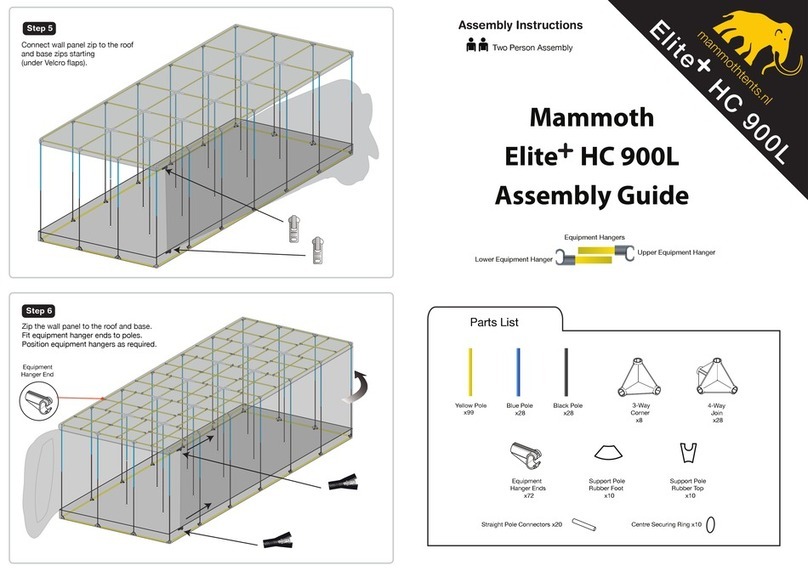
Mammoth
Mammoth Elite HC 900L Assembly guide
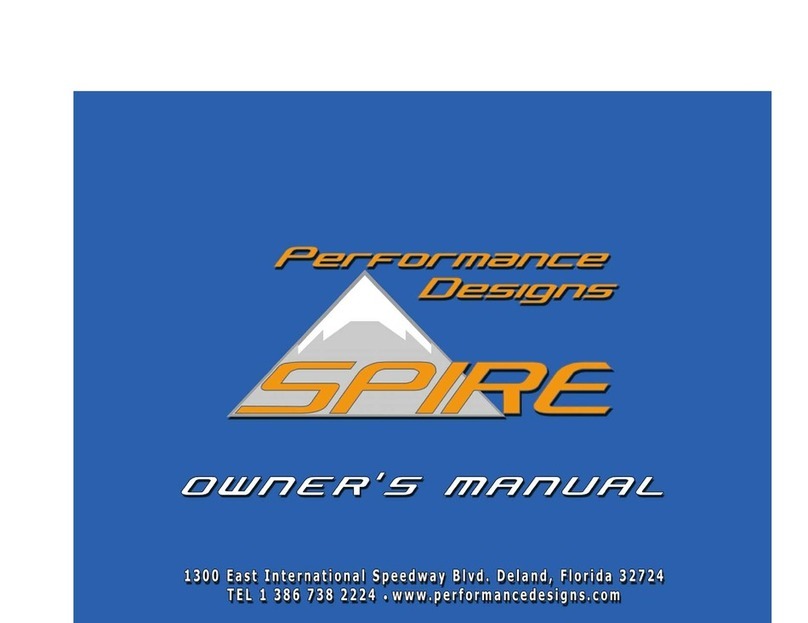
Performance Designs
Performance Designs Spire-08M owner's manual
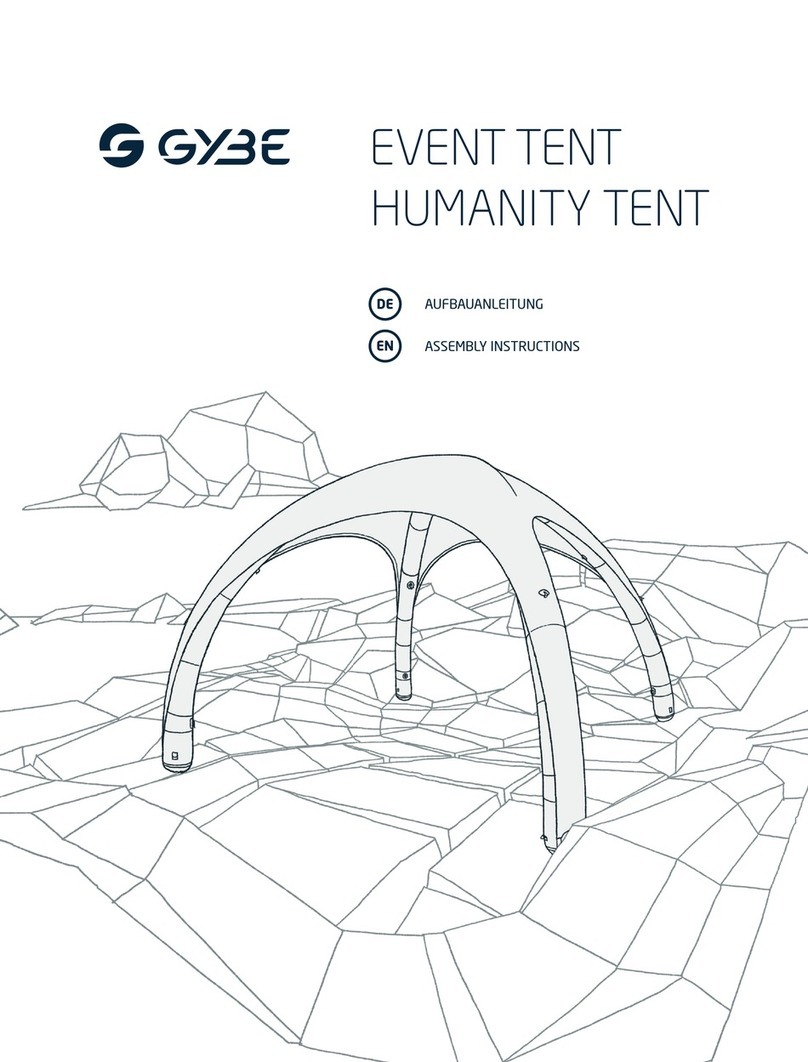
GYBE
GYBE Event Assembly instructions

Napier
Napier SPORTZ COVE 61 Series instructions
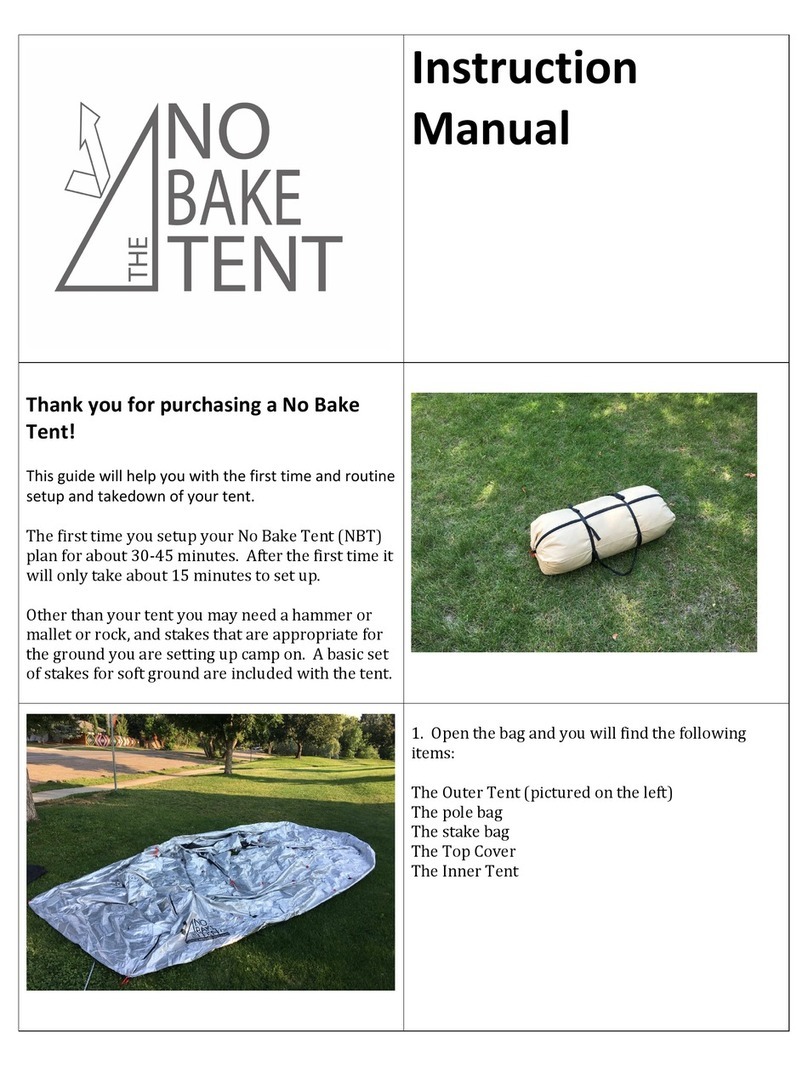
The No Bake Tent
The No Bake Tent The No Bake Tent instruction manual

Sierra Designs
Sierra Designs Alpha quick start guide
